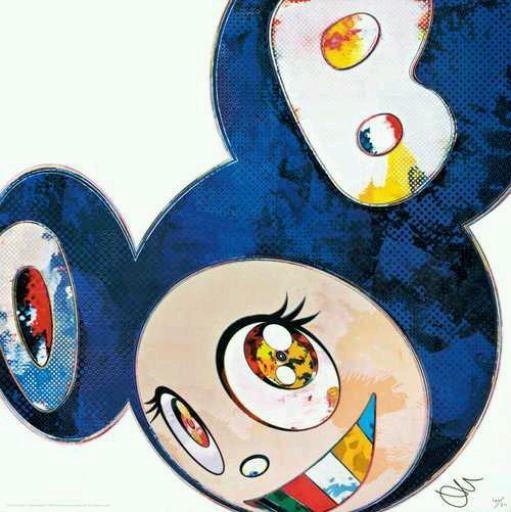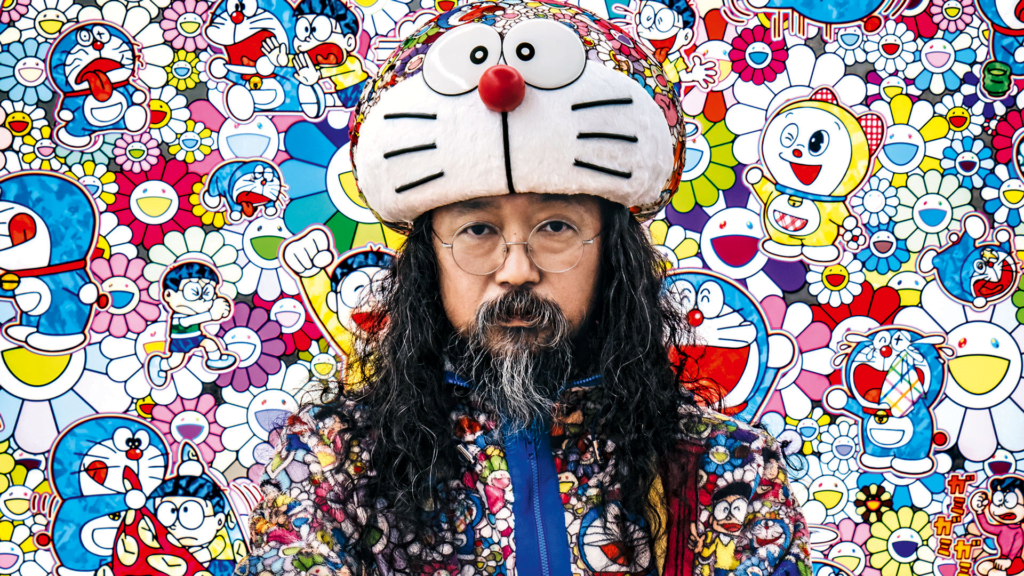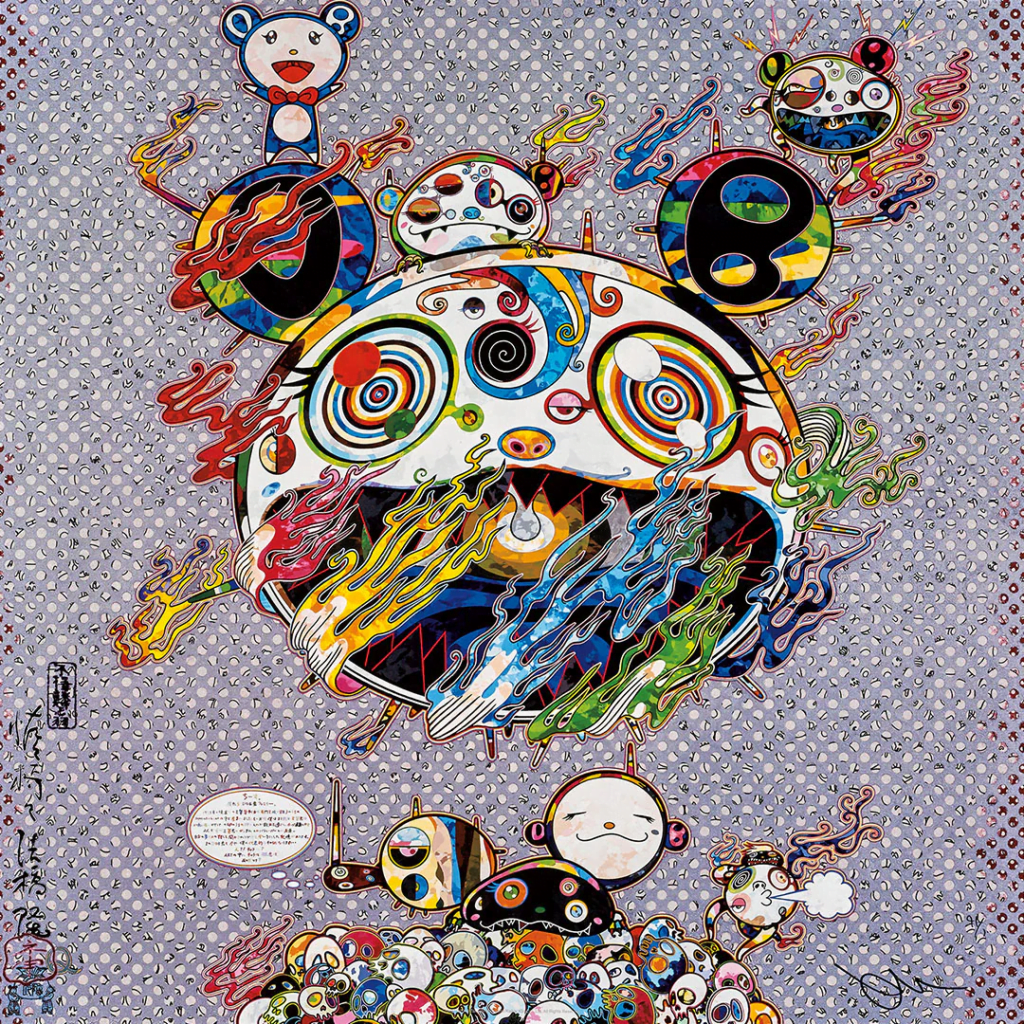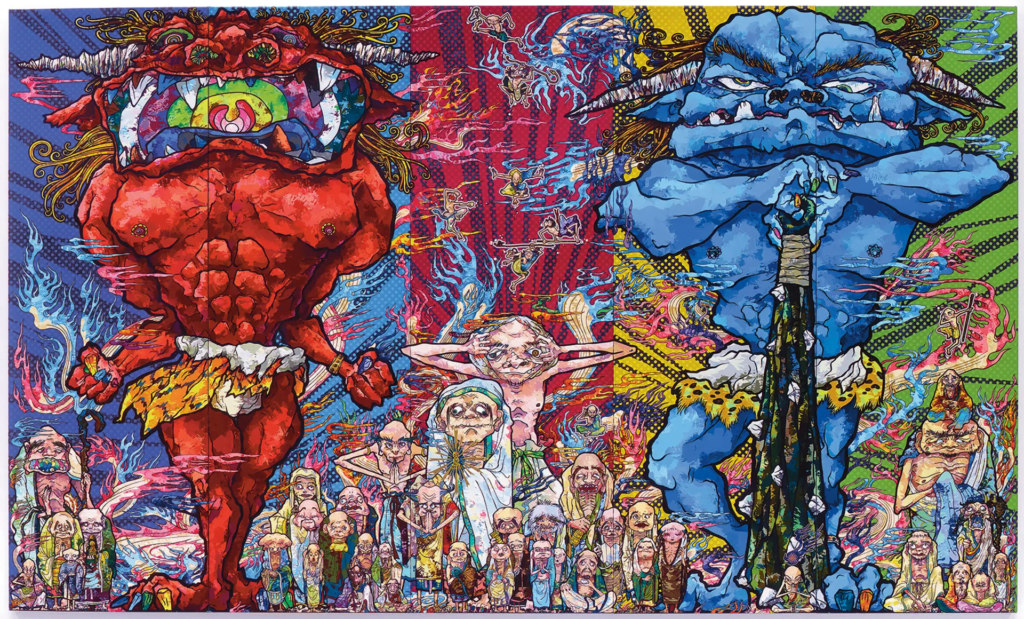Memoriesforart » Artists » Takashi Murakami

More Facts
Name: Takashi
Surname: Murakami
Lives & Works: Itabashi City, Tokyo
Nationality: Japan
Date of Birth: 1962
Period: Post-War
Movement: Contemporary art, Pop art, Superflat
Table of Contents

Born in Tokyo, Japan, in 1962, Takashi Murakami showed an early interest in art. He earned his BFA in 1986 from the Tokyo National University of Fine Arts and Music, where he studied traditional Japanese painting. Murakami became disillusioned with the conservatism of Japanese art education and longed to create works that reflected contemporary pop culture.
In the late 1980s, Murakami travelled to New York City, where he was exposed to Western contemporary art. He studied the art of Andy Warhol, which reinforced Murakami’s interest in mass-produced commercial images from popular culture and his desire to blur the line between high and low art. Upon returning to Japan, Murakami founded the Hiropon Factory, an art collective promoting pop art.
In the 1990s, Murakami developed his signature “Superflat” style, incorporating colourful and playful anime-inspired images with flat, two-dimensional surfaces. His early works provided social commentary on postwar Japan’s materialism and popular culture. Murakami held his first major solo exhibition, “Coloriage,” in Nagoya, Japan, in 1990, which helped launch him into the international spotlight.
Through tireless self-promotion of his brand of pop art, Murakami garnered attention in Japan and beyond. His unique fusion of traditional Japanese painting techniques with contemporary pop culture references and commercialism was a pioneering force that shaped global interest in modern Japanese art. By the late 1990s, Murakami was poised to become an iconic pop artist who brought Japanese pop culture to a worldwide audience.

Takashi Murakami is a complex and enigmatic figure. His works push the boundaries between fine art and pop culture, highbrow and lowbrow. While his art is accessible and playful, exploring themes of commercialism, capitalism, and otaku culture, it is also highly conceptual and intellectual. His fusion of traditional Japanese art with Western pop esthetics has made him a phenomenon and brought Japanese art to a global mainstream audience.
Murakami has revolutionized contemporary art, and his impact will be felt for generations. His ambitious vision, entrepreneurial spirit, and mastery of collaborative partnerships have allowed him to build an artistic empire. Murakami may present himself as the Japanese Andy Warhol, but he is an artist like no other.

Anime, short for animation, refers to Japanese film and television animation styles. Murakami grew up during the rise of anime in postwar Japan and was fascinated by the colourful and imaginative worlds depicted in shows like Astro Boy and Kimba the White Lion. The exaggerated features and emotions of anime characters have inspired Murakami’s signature style.
Manga, Japanese comic books and graphic novels also captivated Murakami early on. Manga typically has more mature and fantastical themes than Western comics. Murakami was drawn to manga’s psychedelic and absurdist elements, which he incorporated into his works.
Beyond anime and manga, Murakami was shaped by Japan’s culture of cute – “kawaii” – and its emphasis on bright colours, cheerful themes and childlike whimsy. His art embraces kawaii but also subverts it with dark, disturbing undertones. This fusion of light and shadow is a metaphor for postwar Japan grappling with its cultural identity.
Murakami is often called “the Andy Warhol of Japan” for pioneering pop art in his country. But while Warhol focused on mass consumerism and celebrity, Murakami is uniquely Japanese. His art reflects Japan’s postwar journey to cultural prominence on the global stage. By blending traditional and modern, cute and creepy, Murakami has established a colourful, rebellious, thought-provoking artistic style in Japanese pop culture. His enormous influence on contemporary art cannot be understated. Murakami is a pop icon and a fine artist all in one.
In the mid-1990s, Murakami gained international acclaim for his unique pop art style. His work incorporated traditional Japanese artistic conventions with popular culture, creating a new contemporary fusion. Murakami established his “Superflat” art movement to protest the hierarchical distinction between high and low art. His style was characterized by vibrant colours, flatness of form, and graphic images from Japanese comics and animation.
Murakami’s initial success came from organizing a series of exhibitions in Japan featuring like-minded artists exploring pop art and Japanese comics. These shows brought him to the attention of prominent Western gallerists and collectors.

One of Murakami’s most significant works is his Superflat art movement and Kaikai Kiki gallery and production company. Superflat combines traditional Japanese artistic conventions with modern pop culture and consumerism.
This postmodern art movement aimed to create a dialogue between historical Japanese art and contemporary subculture. Murakami founded the Kaikai Kiki company in 2001 to promote and produce work by young artists.
Some significant works are:
|
2002 |
Flowers |
|
2002 |
Flower Ball |
|
2001 |
Tan Tan Bo |
|
2003 |
Army of Mushrooms |
|
2003 |
Eye Love Superflat (Black) |
|
2006 |
Flower Matango |
|
2008 |
Poke |
|
2011 |
3-Meter Girl |
|
2010 |
Flowers in Heaven |
|
1999 |
Chaos |
Murakami established the Kaikai Kiki company to support emerging artists in Japan. Kaikai Kiki is a production company, distributor, and promoter for Murakami and other artists. It provides studio space, resources and connections for artists to create and exhibit their work. Kaikai Kiki has helped launch the careers of many influential contemporary Japanese artists, furthering the avant-garde art scene in Japan.
In the early 2000s, Murakami gained international recognition by collaborating with Louis Vuitton. He incorporated his colourful pop style into the luxury brand’s handbags and accessories. The Murakami-Vuitton collaborations brought contemporary art into mainstream consumer culture and elevated Louis Vuitton’s brand. These popular limited-edition collections established Murakami as a fusing art, fashion, and commerce pioneer.
|
Superflat |
2000 |
Murakami curated a “Superflat” art exhibition to showcase his postmodern art movement. Superflat rejected the depth and perspective of traditional Japanese painting in favour of bright colours and flattened forms. Murakami combined the flatness of Edo period woodblock prints with modern pop esthetics influenced by manga and anime. |
|
Fondation Cartier in Paris |
1996 |
Murakami had his first solo exhibition outside of Japan. This showcase of his colorful and whimsical paintings propelled him to fame in the European art world. |
|
“Coloriage” |
2001 |
He had an exhibition at the Museum of Contemporary Art in Los Angeles. His show “Coloriage” featured large-scale paintings, sculptures, and videos that fused Japanese artistic styles with American pop culture. |
Instagram: https://www.instagram.com/takashipom/
Facebook: https://www.facebook.com/takashi.murakami.142/
Twitter: https://twitter.com/takashipom